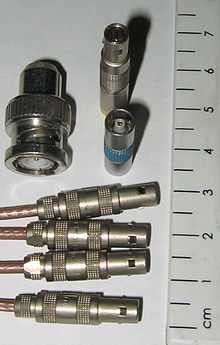LEMO

LEMO is both the name of an electronic and fibre optic connector manufacturer, based in Écublens, Switzerland, and the name commonly used to refer to push-pull connectors made by that company. LEMO connectors are used in medical, industrial, audio/visual, telecommunications, military, scientific research and measurement applications. The company, founded in 1946, started as a manufacturer of contacts in noble and rare metals. The company took its name from the company founder, engineer Léon Mouttet.
LEMO has set several connector standards. The 3K.93C connector[1] has been adopted by the American (SMPTE 304M), Japanese (ARIB BTAS-1005B) and European (EBU R100-1999) standards organisations for HDTV fibre links for the broadcast market. The LEMO 00, a miniature push-pull 50Ω coaxial connector, is used as front panel connectors in the Nuclear Instrumentation Module (NIM) and Computer Automated Measurement and Control (CAMAC) modular electronics standards used in instrumentation for nuclear and particle physics, where it is used as a replacement for BNC connectors in high density designs (because the LEMO connector is much smaller in size than a BNC).
While LEMO connectors were generally developed as proprietary designs, the legal status of many of the older designs is not clear. For example, the LEMO website itself shows a standardisation date of 1970 for the LEMO 00 model. The "chocolate plate" design of the connector's shell grip is, however, trademarked.[2]
References
- ↑ LEMO 3K.93C Catalogue
- ↑ USPTO registered trademark number 2703464, see